After another eventful Copa do Brasil edition, all roads have led to a Clássico do Povo final. Clássico do Povo, which translates to Derby of the People, is the name given to the interstate derby between Brazil’s two biggest fan bases. Corinthians, who have had a relatively successful year under Portuguese manager Vitor Pereira, come into this final with the only opportunity remaining for silverware this season. On the other hand, Flamengo have reached the final of both the Copa do Brasil and the Copa Libertadores under Dorival Júnior. At any rate, with two of the biggest clubs in the continent, the Copa do Brasil final plays host to a historic battle.
The Brazilian Cup is rather unique in the sense that the final is played over two legs, with both clubs being able to play in front of their home crowd. Last Wednesday, the first leg took place in São Paulo, with Corinthians hosting a 0-0 draw. The first encounter proved to be an incredibly competitive battle between two evenly matched sides. Both teams were rather cautious in their tactical approach, resulting in a goalless stalemate. Nonetheless, the tactical scenario is set up and the tie is wide open as the Maracanã hosts the second leg.
In this tactical analysis, we will examine the key tactical points that dictated the development of the first leg. More specifically, this analysis will explore how both teams matched up against each other, their respective strategies, and where each team can find the edge in the second leg.
Lineups and formations
While Corinthians have recently seen some slight variations in their tactics, neither team has changed much since their last encounter in the Copa Libertadores quarter-final. Flamengo lined up in their usual 4-3-1-2, a narrow formation which is rarely seen nowadays. With Santos in goal, Dorival’s backline consisted of Rodinei, former Chelsea centre-back David Luiz, Léo Pereira, and former Atlético Madrid left-back Filipe Luís. In the midfield, Thiago Maia was flanked by João Gomes and Éverton Ribeiro. At the heart of Flamengo’s structure, Giorgian de Arrascaeta was the attacking midfielder and playmaker. Ahead of him, World Cup-bound Pedro played alongside Premier League-linked Gabriel Barbosa, also known as ‘Gabigol’.
For Corinthians, Vitor Pereira has recently given up on his notorious squad rotation which marked an inconsistent first half of the season. On the contrary, the Portuguese manager has adopted a consistent approach looking to optimise the natural interactions and relations between his star players. Corinthians began the match with an asymmetric 4-3-3, a structure which can easily be viewed as a 4-2-3-1 at times.
Club legend Cássio was in goal behind an extremely experienced backline. Fagner and Fábio Santos were the fullbacks while Gil and Fabián Balbuena formed a centre-back partnership. In the midfield, Fausto Vera sat slightly deeper while the contrasting duo between Renato Augusto and Du Queiroz operated further ahead. Finally, the front three consisted of Róger Guedes, Yuri Alberto, and Adson.
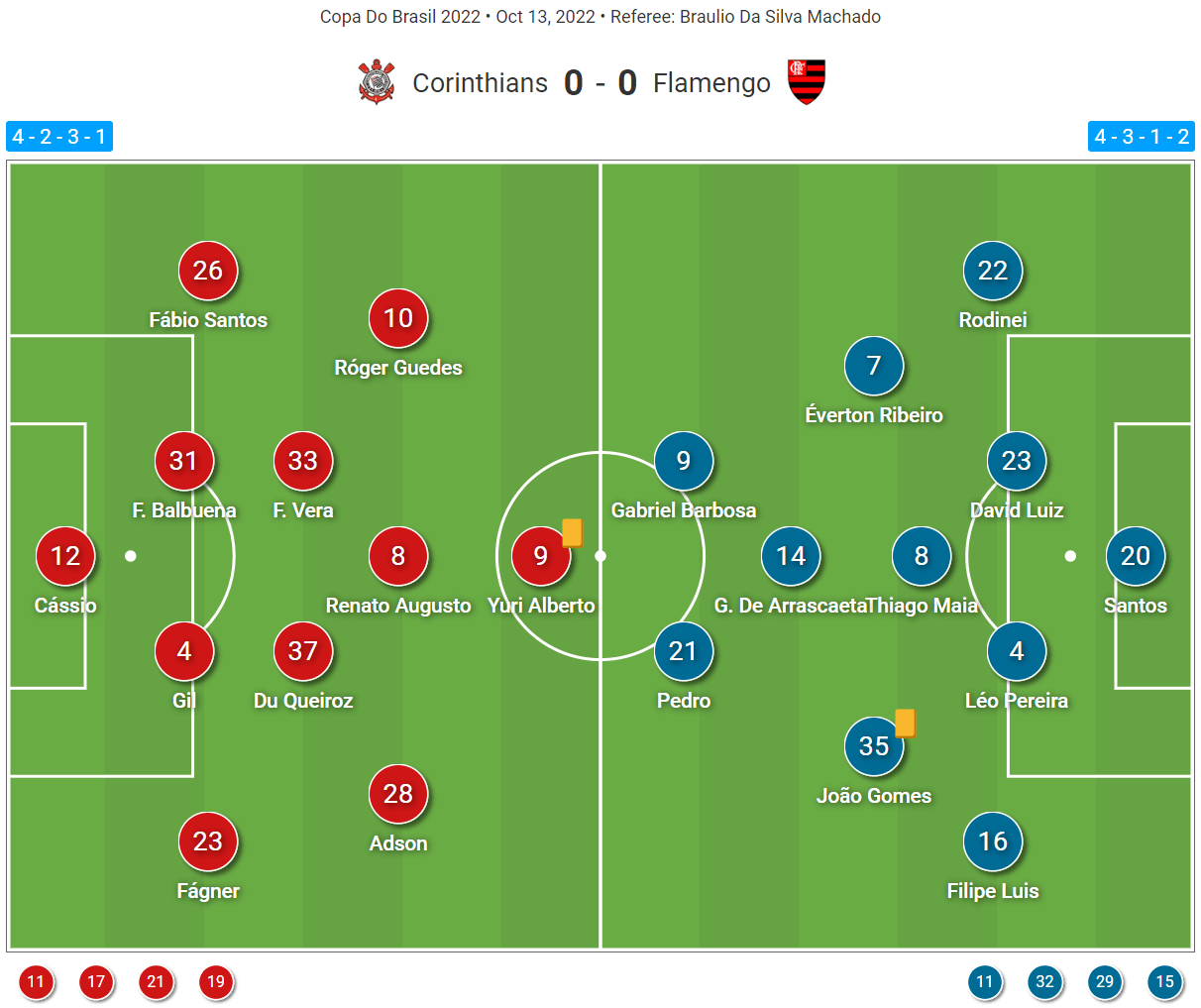
In the second leg, the same setups can be expected. While a completely rotated Flamengo side defeated Atlético Mineiro 1-0 over the weekend, Timão’s league match against Goiás was postponed due to legal complications. As a consequence, both teams will come into this second leg with their squad at full capacity. Now that the stage is set up, we can look at the tactics behind this fascinating encounter.
High press battle
In the first 10 minutes, there were next to no organised positional attacks. In the first leg of the Copa Libertadores quarter-final, Flamengo quickly assumed control of the match with a far superior high press. Refusing to make the same twice, Corinthians aimed to match Flamengo’s defensive intensity and keep them from imposing themselves in possession. Consequently, in the first 15 minutes, both teams had a long pass percentage of over 12, with a certain lack of control from either side.
Vitor Pereira’s side pressed with a very narrow front three, with both wingers tucking in alongside Yuri Alberto. In addition to the structure highlighted above, Corinthians advanced their midfield trio to match Flamengo’s three central midfielders.
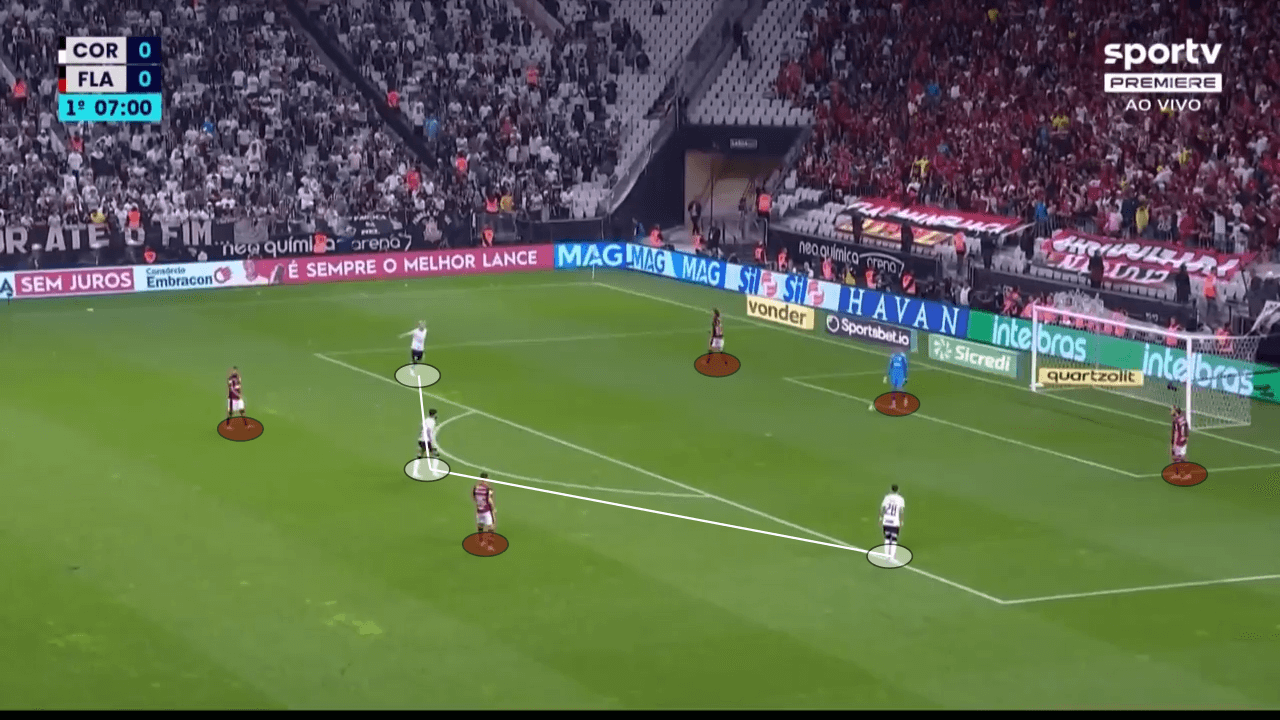
At the other end, Flamengo pressed with similar aggressiveness. The two centre-forwards led the high press, looking to immediately advance on Timão’s centre-backs. In the midfield, Arrascaeta marked Fausto while João Gomes and Éverton Ribeiro marked Du Queiroz and Renato Augusto, respectively. Despite the Rio de Janeiro side lacking width in their press, Corinthians were unable to reach and exploit the wide areas.
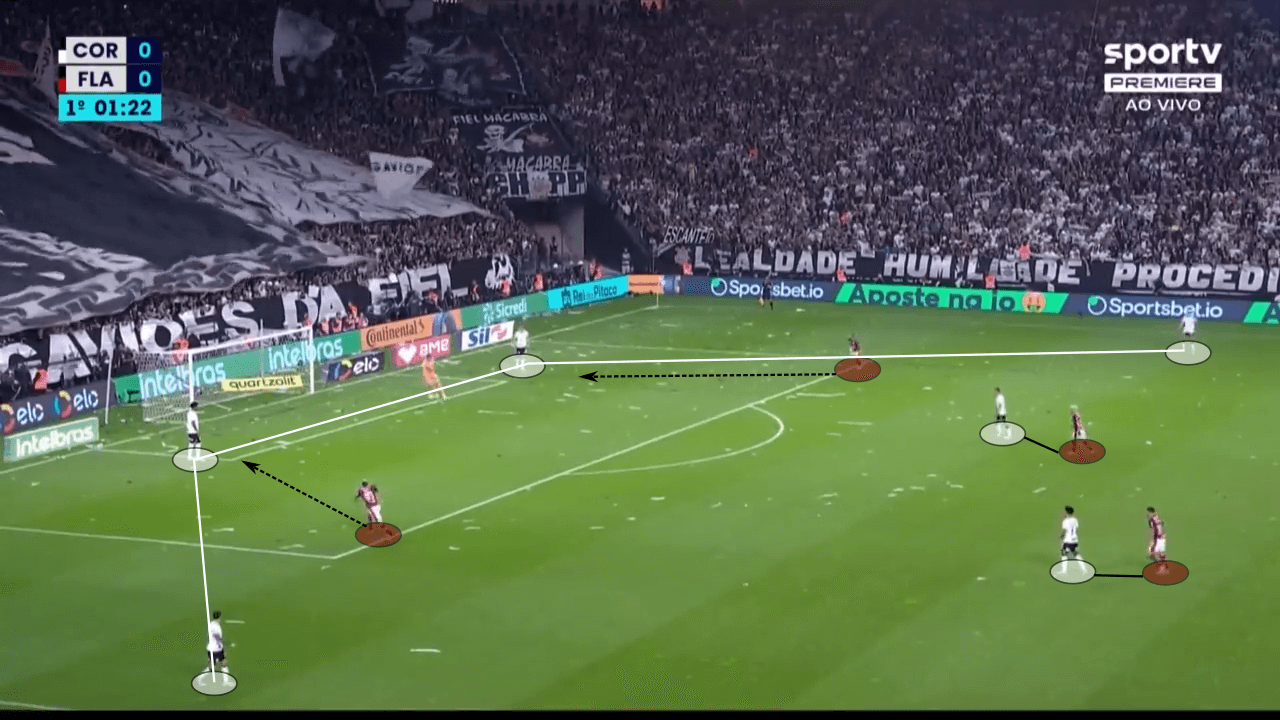
Despite an initial stalemate in the battle for control, Flamengo were able to overcome Vitor Pereira’s press and impose themselves slightly more than Corinthians. As the match went on, this control became more evident. Mengão finished the match with 58.49% possession, and although Corinthians had some spells, Flamengo were superior for most of the match.
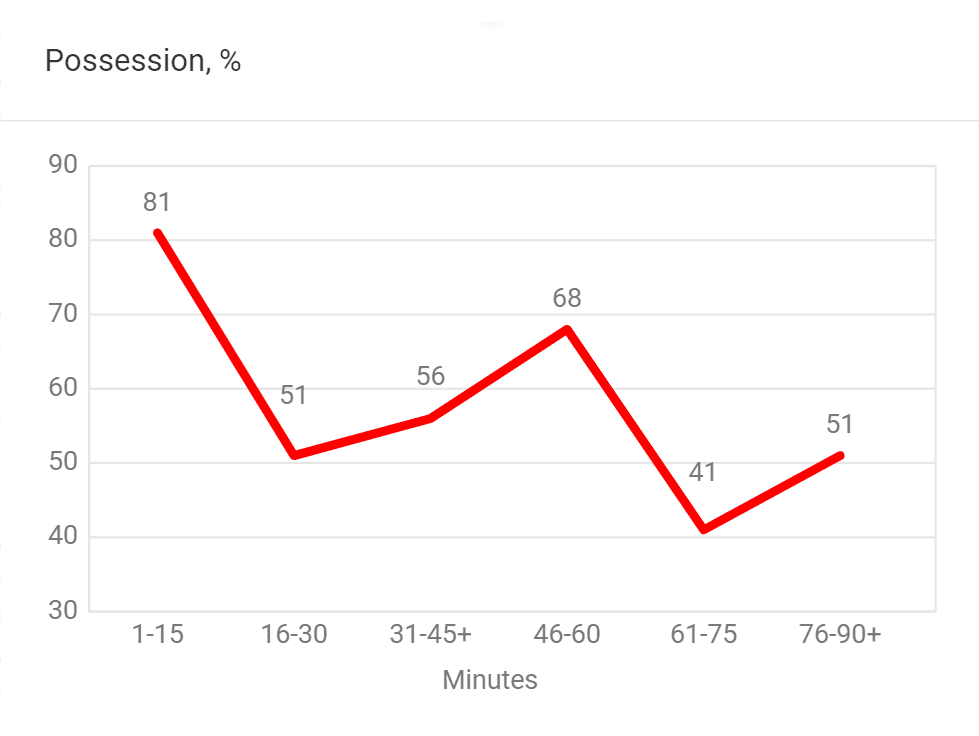
With a 4v3 superiority in the backline, Flamengo were able to progress into central areas. In these areas, Corinthians’ midfield trio man-marked Flamengo’s midfield. This left them with no extra man, and when Flamengo’s defenders advanced into this area, they were able to create superiority and progress into the middle third.
In the example below, as Adson tries to keep Filipe Luís from playing it to the centre-back, Filipe Luís carries the ball into the central areas. With Renato Augusto man-marking Thiago Maia and Du Queiroz on João Gomes, Filipe Luís had the freedom to drive further up the pitch.
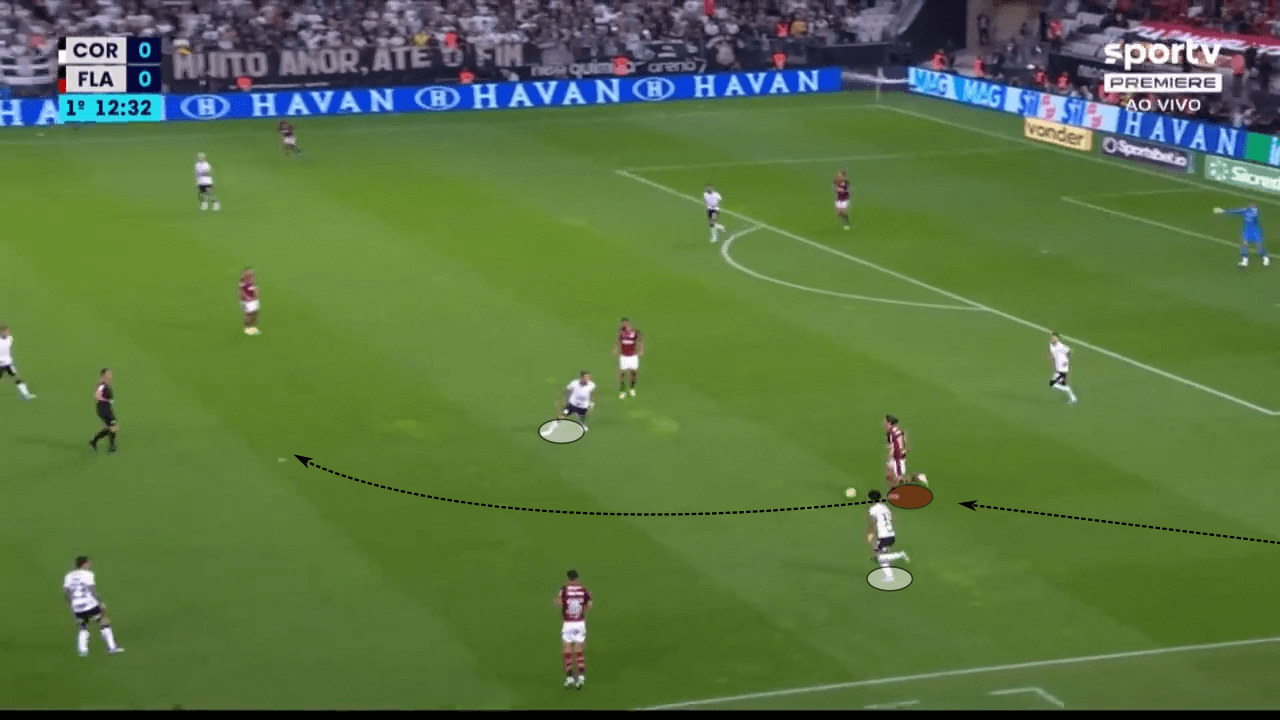
Another strategy Flamengo used to beat the press was exploiting Corinthians’ narrow front three. In the example below, as Corinthians focus their press on their right side, Guedes tucks in on David Luiz. While this keeps their pressing structure very compact, it leaves Rodinei, the opposite fullback, with a lot of space. After Léo Pereira finds him, Rodinei has the time and freedom to advance into the middle third.
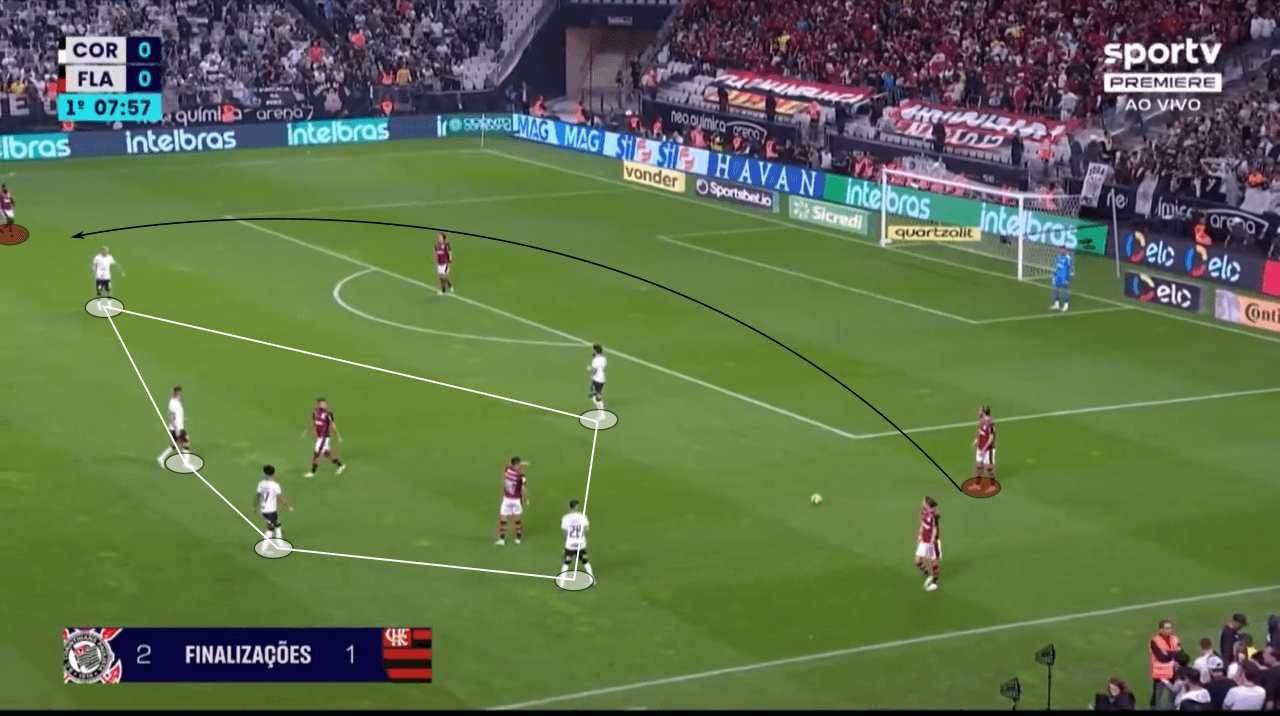
Overall, while initial chaos was created on both ends, Flamengo were able to find more control in possession. While this can be attributed to superior performance with the ball, both teams’ defensive intensity also played a large role. Corinthians finished with a PPDA of 11.33, a much higher figure than Flamengo’s 7.38. This defensive intensity is perhaps what guaranteed Flamengo’s dominance, as when Vitor Pereira’s side reverted to a low block, they were much more passive.
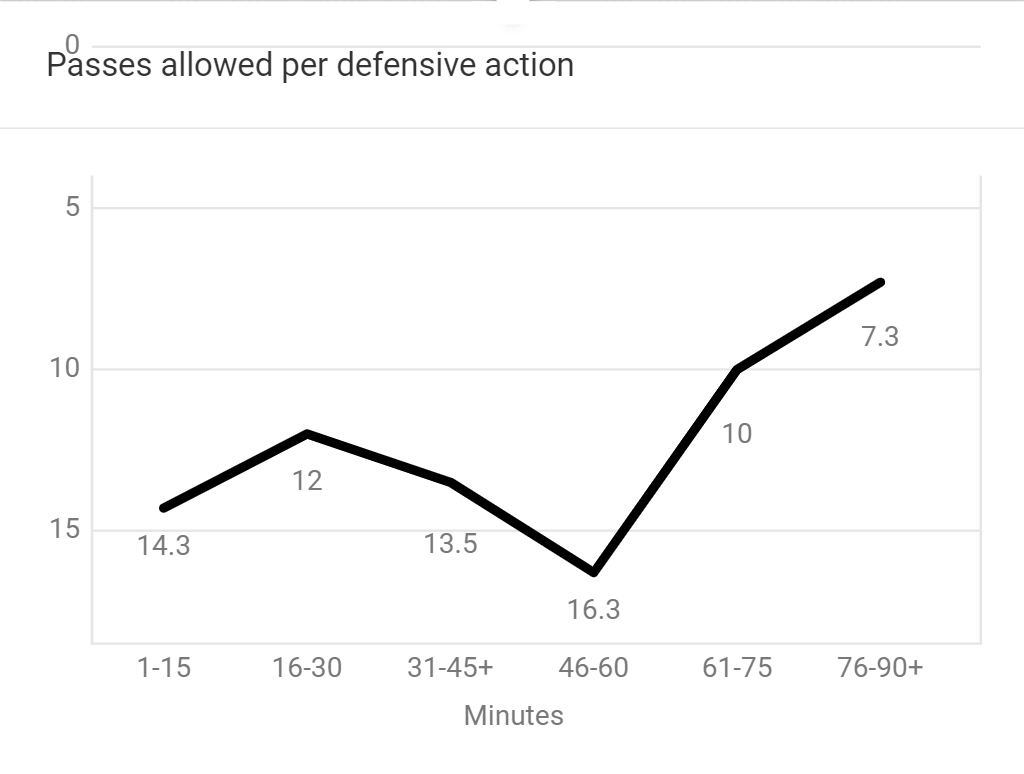
Contrastingly, Flamengo maintained an impressive intensity in lower blocks, allowing the São Paulo side little to no time on the ball. With a coordinated structure, as seen in the image below, they were able to remain aggressive in lower blocks. In the example below, as Corinthians try to progress into the final third, Flamengo suffocate them into giving the ball away by closing down passing options and pressuring Fagner.
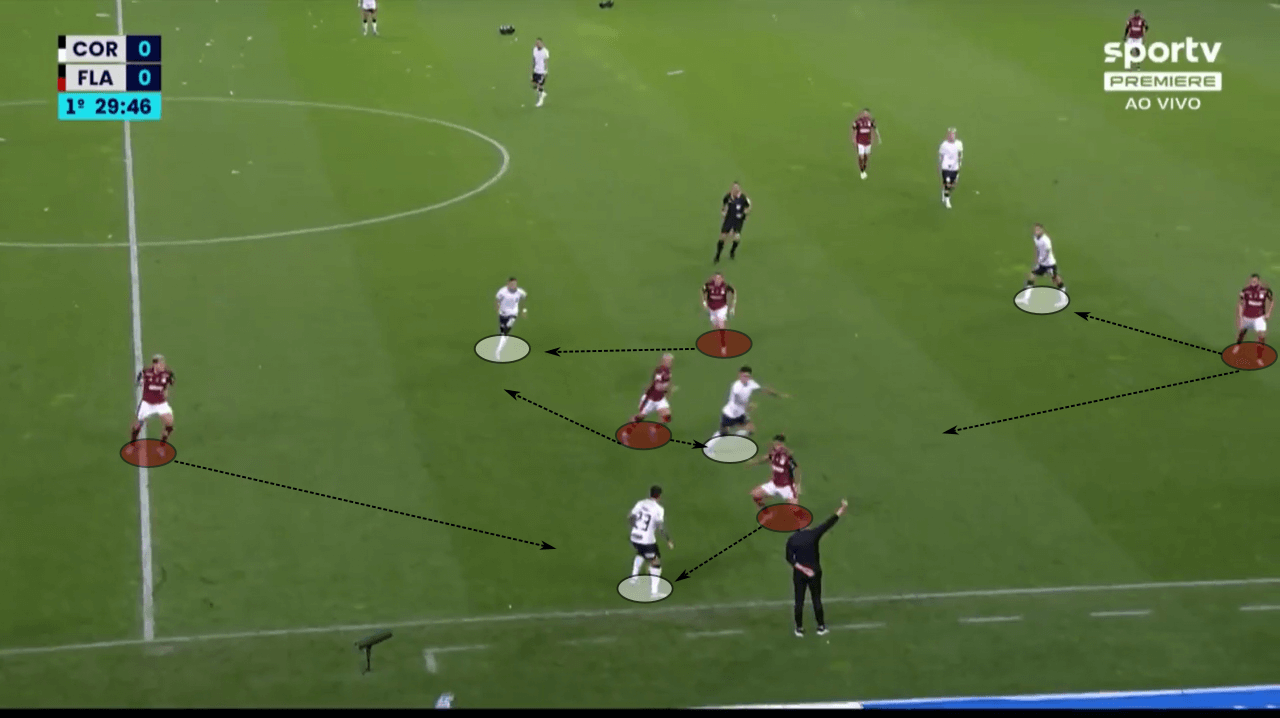
Corinthians’ struggles
Despite Flamengo dominating possession, both teams enjoyed their fair share of positional attacks. While Corinthians only had 41.51% of possession, their 28 positional attacks were similar to Flamengo’s 29. The xG figures, however, were nowhere near as balanced. Flamengo’s 1.05 nearly doubled Corinthians’ 0.66. This contrasting difference in chance creation highlights how ineffective Vitor Pereira’s side was in creating clear opportunities. Their shot map below highlights how despite having 14 shots in the match, none of them were from dangerous locations.
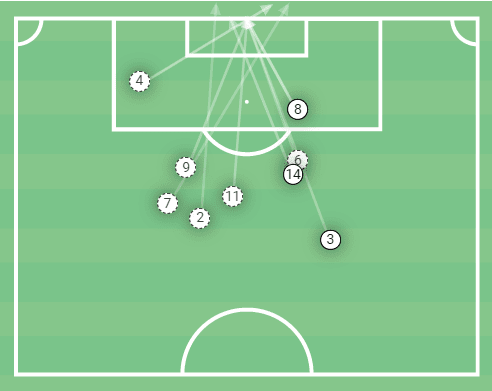
This was a direct result of how Dorival’s compact low block was able to completely nullify Vitor Pereira’s attacking strategy. Since Jorge Jesus’ departure in 2020, Flamengo struggled to find defensive stability through multiple managers. Dorival, however, was able to restore this with an impeccable defensive system.
After progressing through the wide channels, Corinthians aimed to create through the half-spaces. Both of Timão’s wingers were playing with an inverted dominant foot, and as a consequence, rarely looked to take the ball down the line. On the contrary, after reaching the final third, Corinthians looked to cut inside and create in the half-spaces.
There was a significant disconnect, however, between the wide channel and the half-space. Corinthians struggled to create positional superiority and dynamic passing lanes to penetrate Flamengo’s block. As seen below, they had meaningless possession without much danger most of the time.
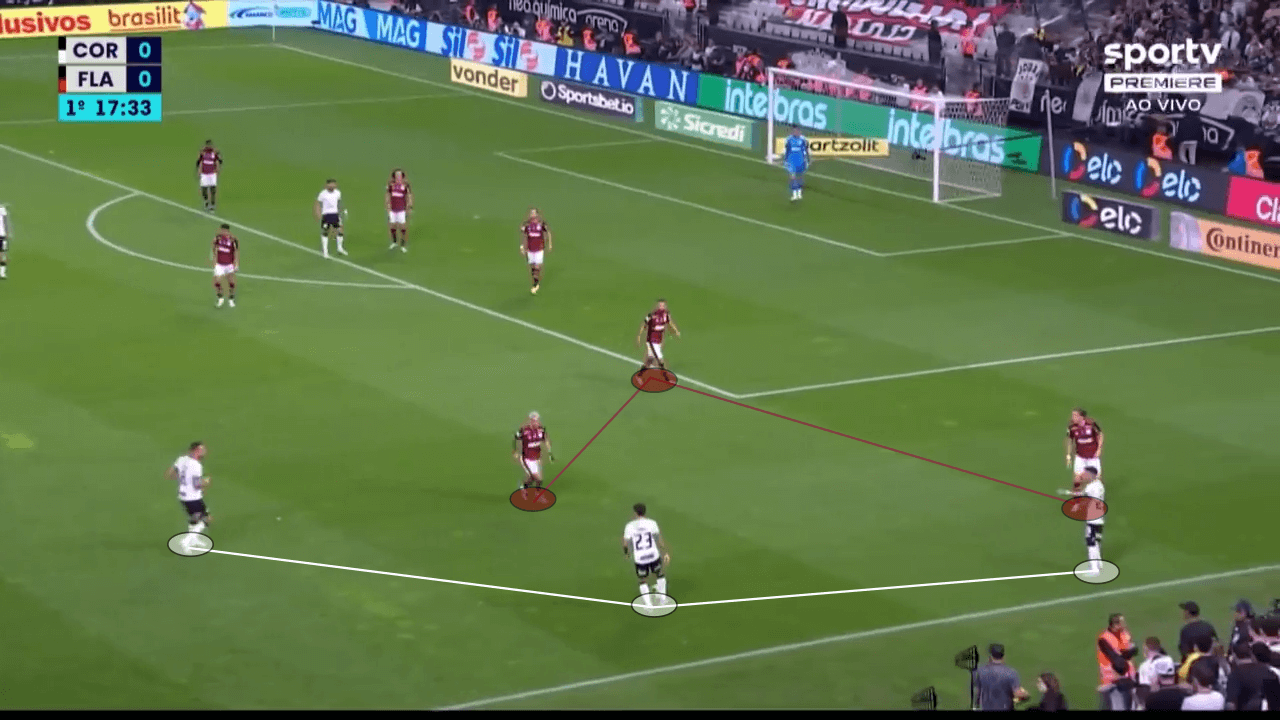
When they did play into the half-space, they were immediately met with an overwhelming number of Flamengo players. Dorival’s men were able to revert into extremely compact blocks and allow next to no space for Corinthians to explore.
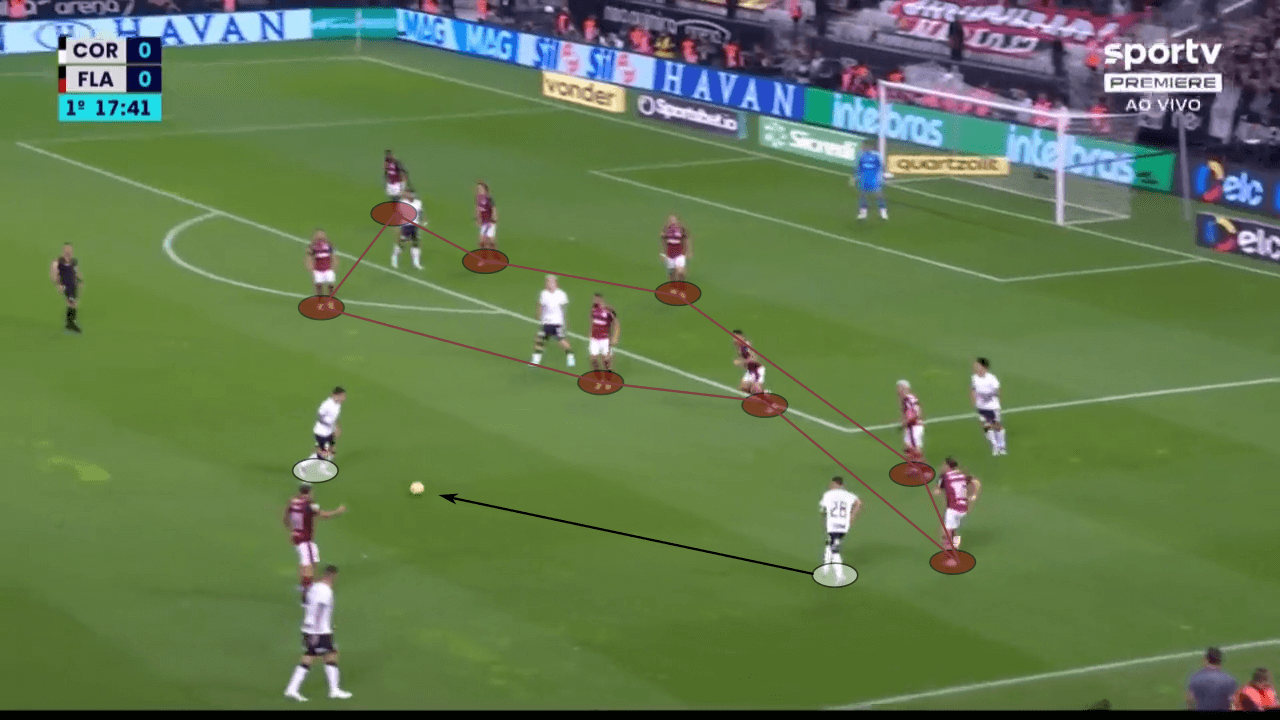
In the image above, it is clear how Corinthians focus their entire attack on this specific section of the pitch. In the second leg, the key, however, may lie in maintaining maximum width in their positional attacks. Similar to Pep Guardiola’s teams, by deploying a positional-play guided structure, they would be able to stretch and exploit Flamengo’s low block. In this setup, switches of play, which Renato Augusto and Vera can easily perform, would be extremely effective. Additionally, creating in wide areas would prove much easier.
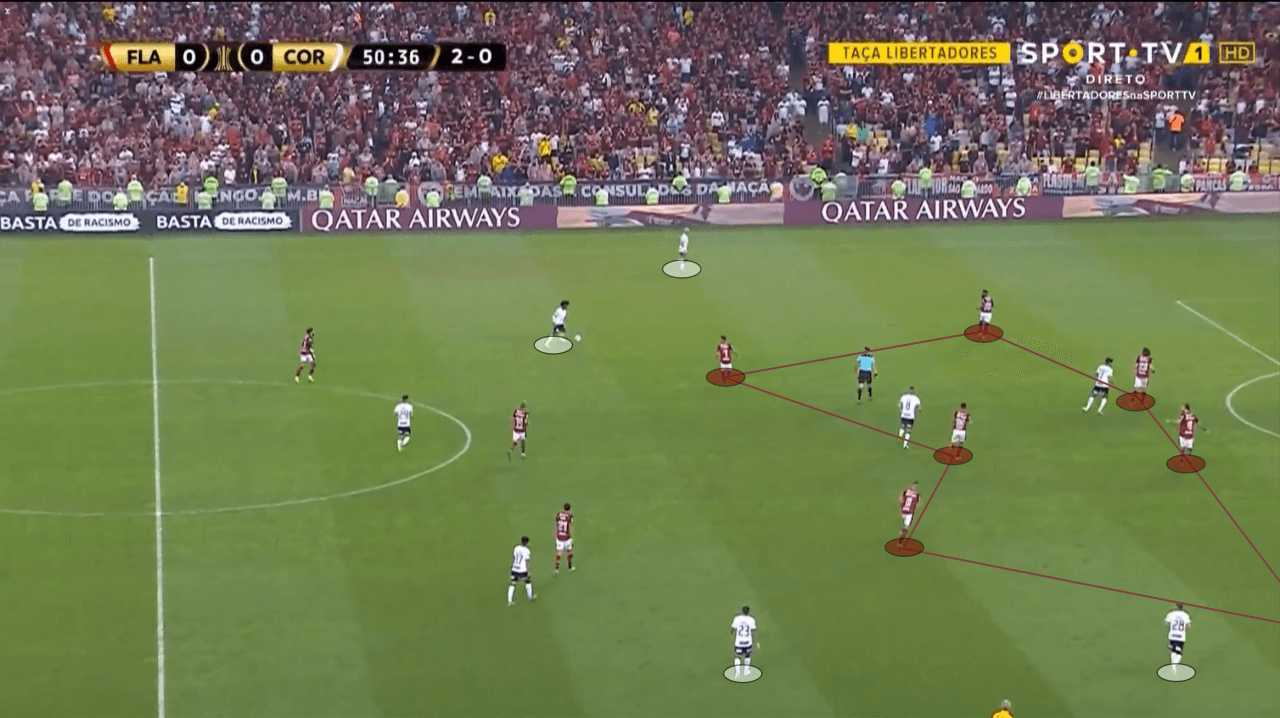
In the example below, after Fábio Santos, Willian, and Renato Augusto try to create through the left wing, the ball is played centrally and Du Queiroz is able to exploit an overlapping run by Fagner on the opposite wide channel.
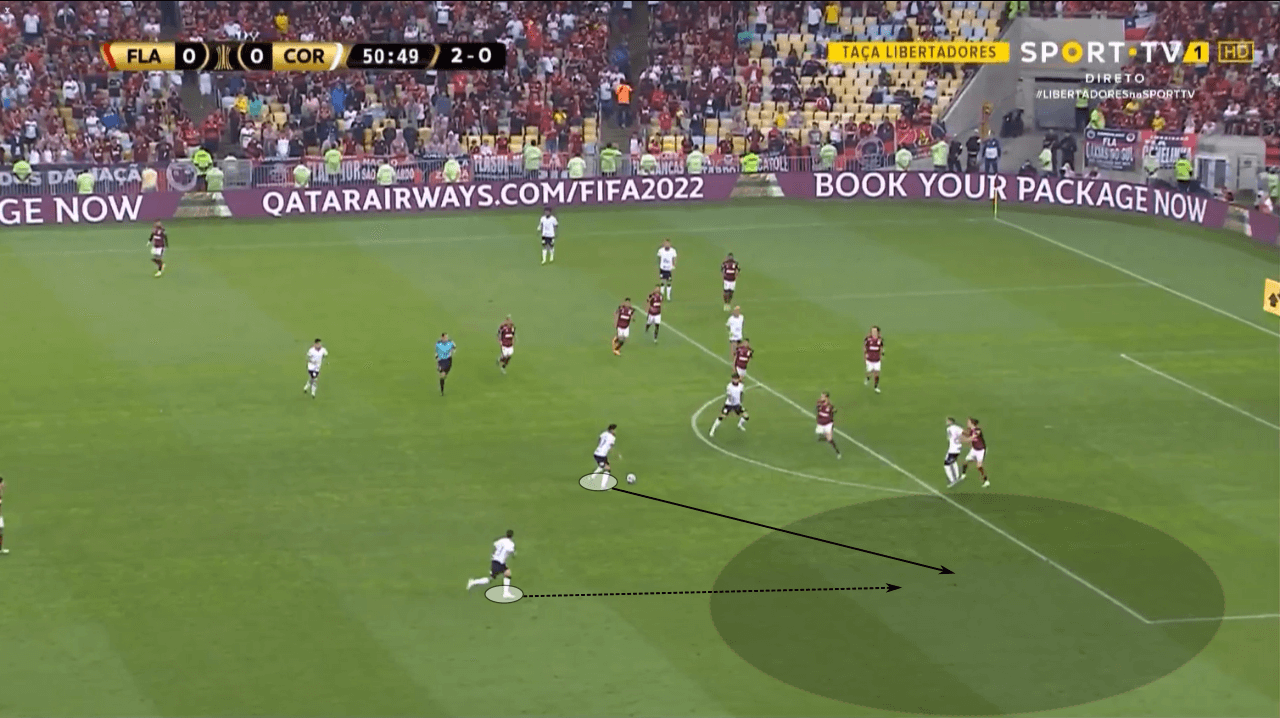
In the wide areas, Corinthians must also create more effective passing lanes. In the second leg of the Copa Libertadores, Corinthians had a brief spell in the second leg where they showed flashes of a dangerous attacking system. One of the factors behind this was their ability to take advantage of the wide areas.
In the instance below, despite being numerically inferior, they create an effective passing network through diagonal passing lanes and angles. If Corinthians wish to create through the wide areas, they must be more intelligent with their individual positioning.
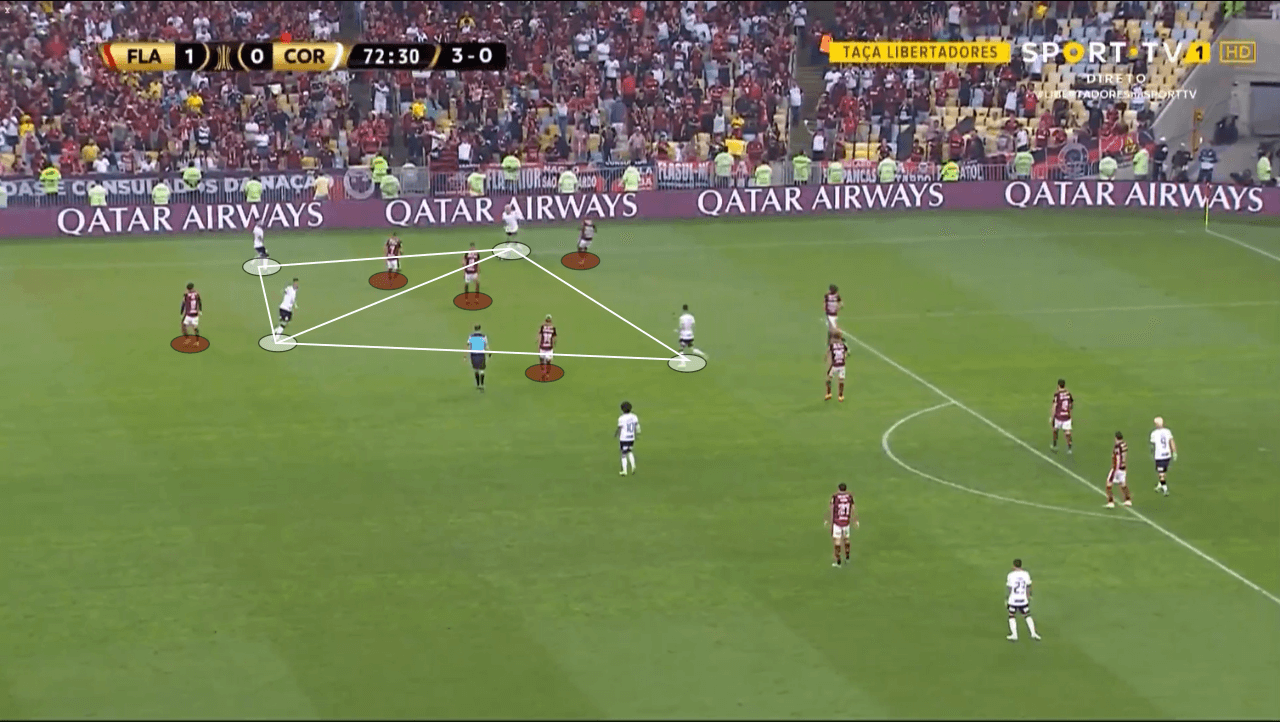
The keys for Flamengo
Similar to Flamengo, Coringão often dropped into low and compact blocks. Allowing minimal space in between defensive lines, they were able to keep Dorival’s men from easily creating chances. Nonetheless, Flamengo still posed danger due to a few factors. Before we look at them, it is worth highlighting what Vitor Pereira’s low block looked like. With the wingers dropping deep, they reverted into a 4-1-4-1/4-5-1 as Yuri Alberto sat higher.
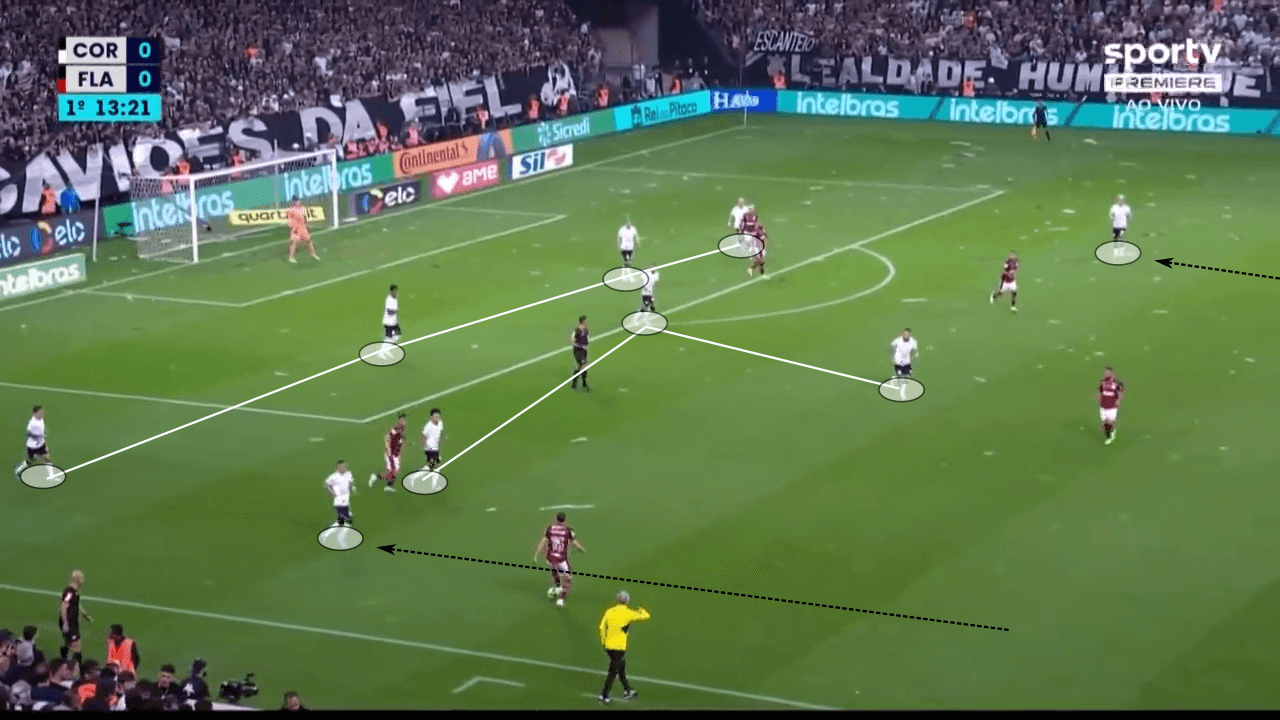
When sitting high, Yuri Alberto was faced with a 2v1 battle against Flamengo’s centre-backs. Especially with David Luiz, Flamengo have dangerous ball-playing defenders. As Yuri was unable to constantly press them, they were able to have time and space on the ball to create. David Luiz completed seven of his 11 attempted passes into the final third, with a few good chances coming from them.
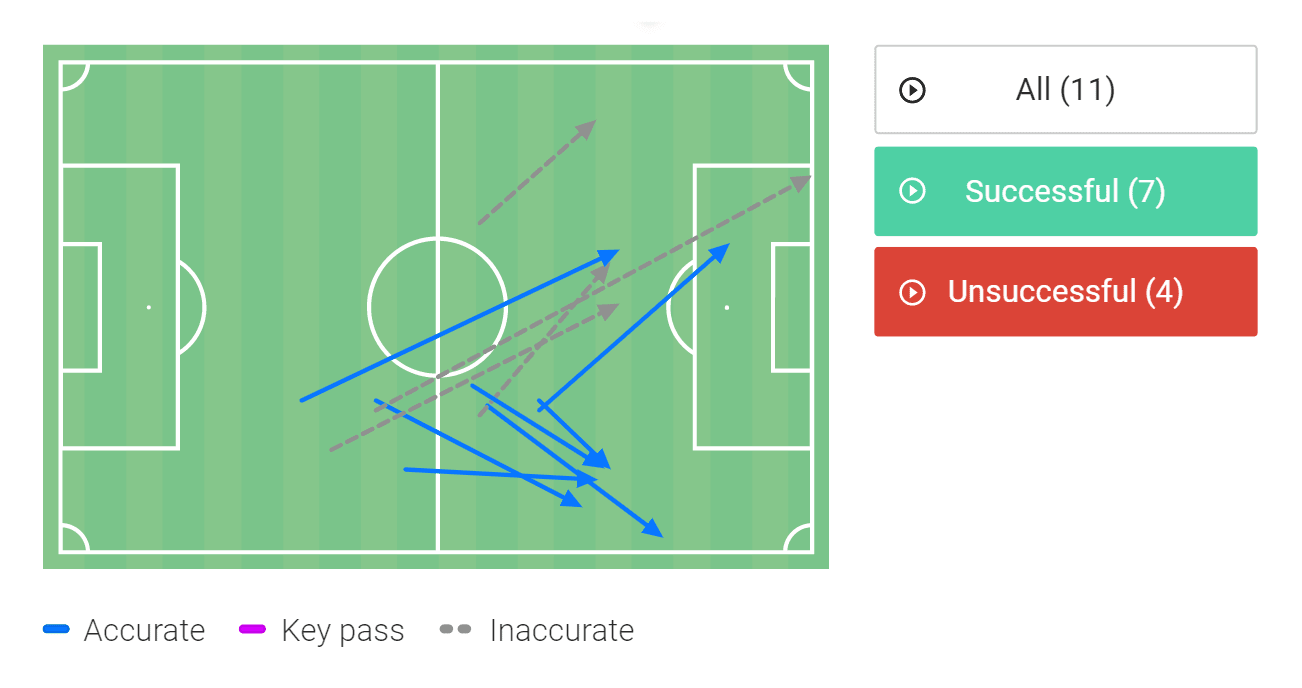
The most notable one came after finding Gabriel Barbosa in the final third. With time and space, David Luiz picks out a line-breaking pass to Gabigol just outside the box. Gabi immediately plays it to Pedro who lays him off for a dangerous shot.
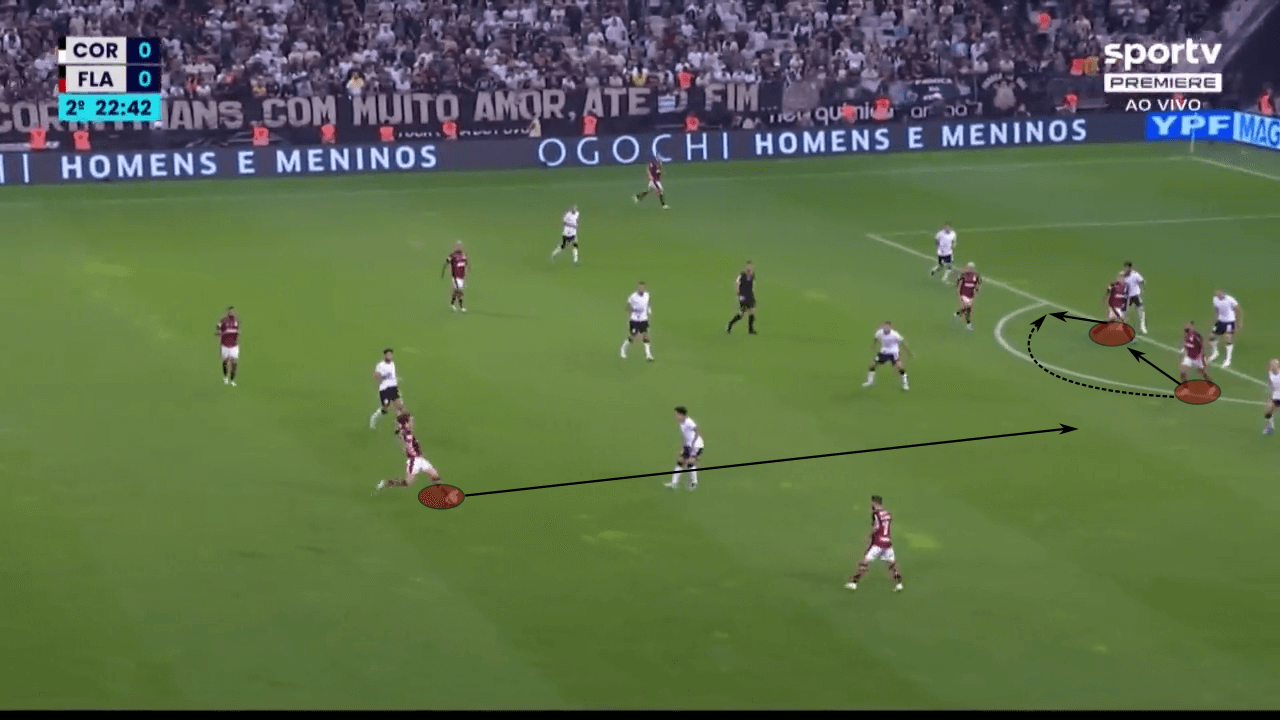
In fact, Flamengo’s combinations and interactions in tight spaces were a huge factor behind their success on Wednesday. With extremely talented attackers, they are able to maintain control and create inside Corinthians’ defensive structure. In the example below, Filipe Luís finds Pedro who immediately lays off Éverton Ribeiro before spinning off and receiving it again behind the backline.
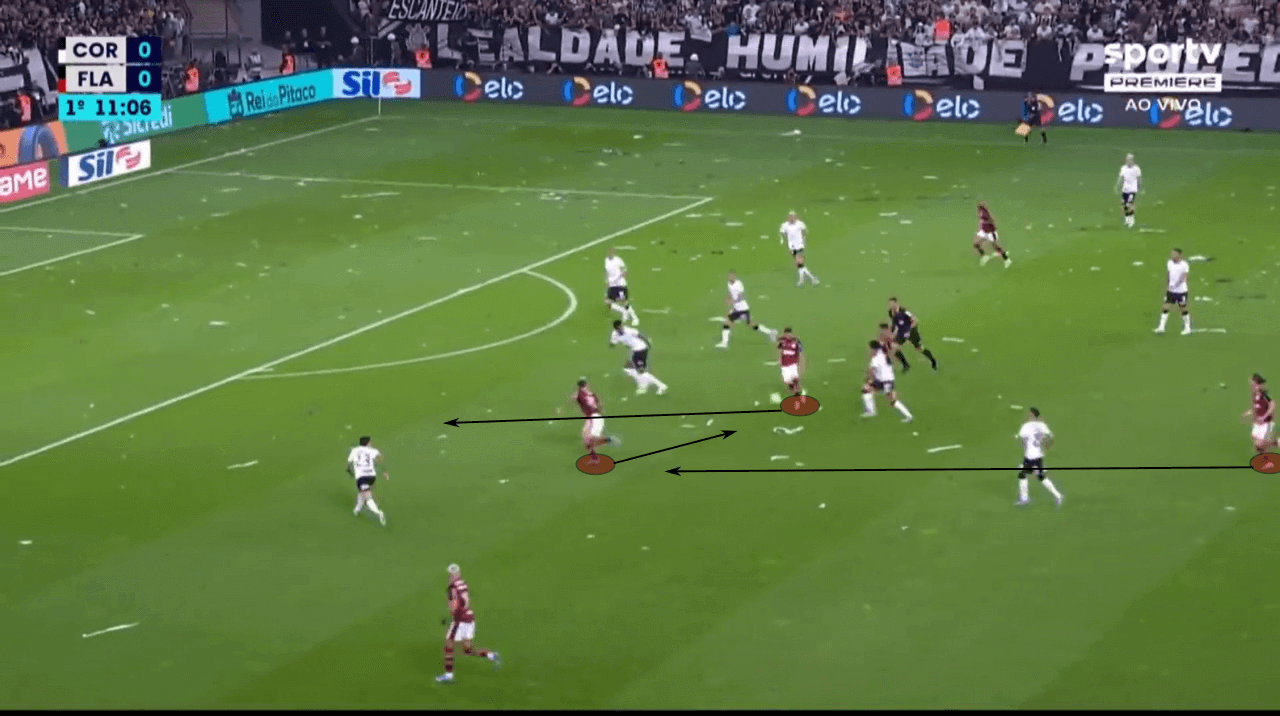
In addition to effective interactions, Flamengo were able to use constant mobility to manipulate and create space within Vitor Pereira’s defensive structure. With his constant movement, Gabigol is able to lead this and constantly confuse and disorganise Corinthians’ backline.
In the example below, he drags Balbuena out of position as he drops in to receive a ball. Meanwhile, while Rodinei keeps Fábio Santos wide, Arrascaeta attacks the space left by Gabigol and drags Gil along with him. After receiving it, Gabi turns with the ball and drives into the opposite side, where Pedro is left in a 1v1 with a Fagner. They exploit this superiority and create a dangerous opportunity.
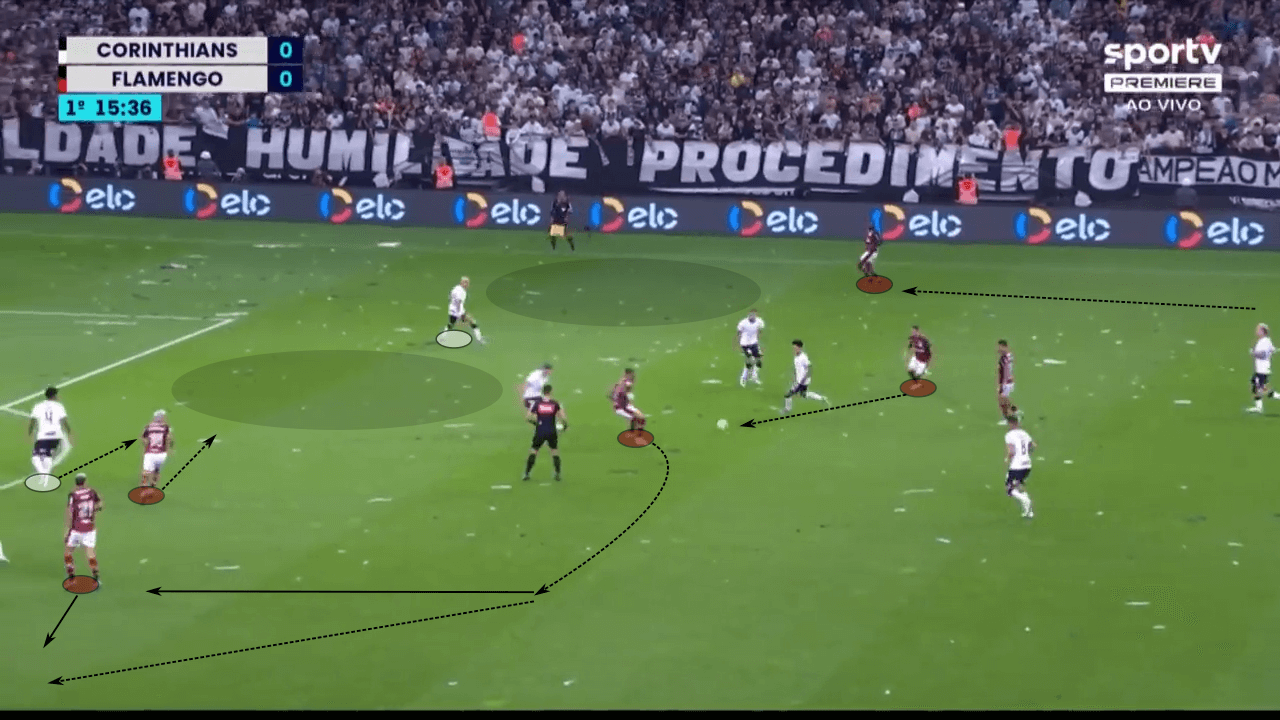
In another instance, Gabigol’s movement helps Flamengo advance into the opposition box. Gabi comes across while Arrascaeta drives forward. As Balbuena refuses to follow him, Gabi is free to attack the space behind Fagner, who is already occupied with Filipe Luís on the wide channel. Essentially, with great mobility, Flamengo create a 3v1 scenario within Corinthians’ low block.
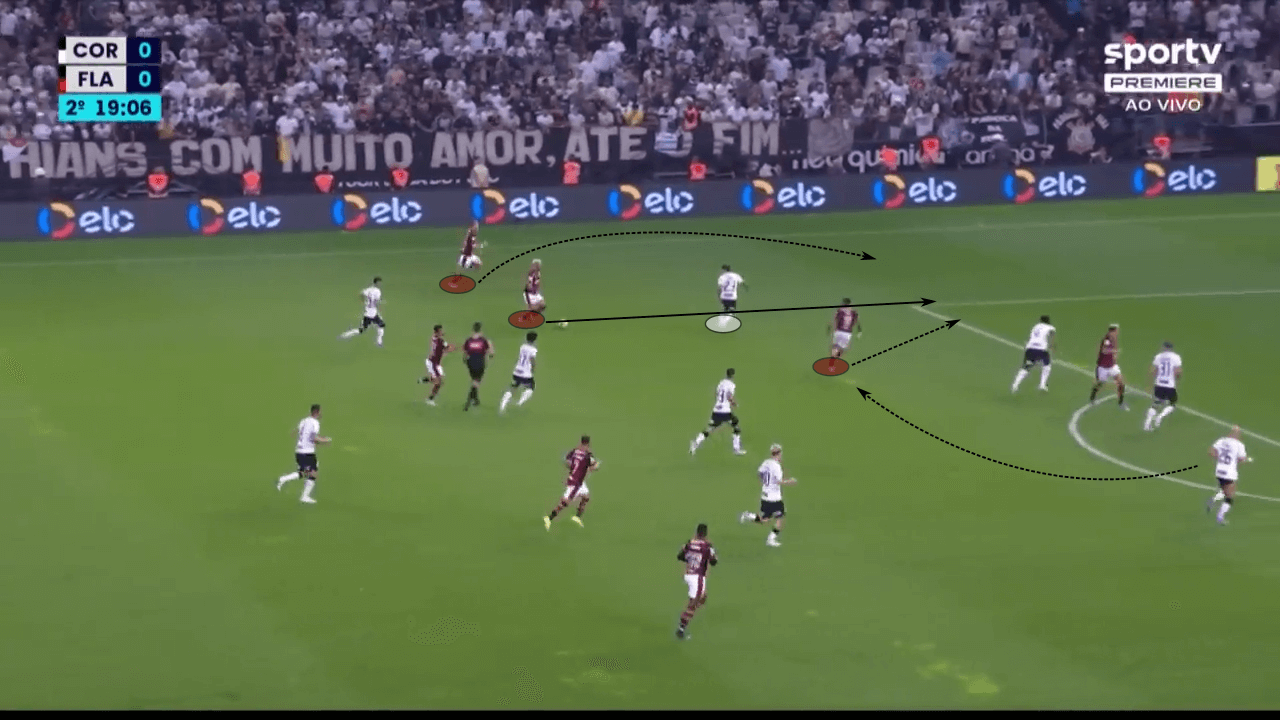
Conclusion
The first leg between Corinthians and Flamengo proved to be a tight tactical battle where neither team was able to come away with a result. Nonetheless, a fascinating tactical contest was set up for the second leg at the historic Maracanã.
While Flamengo found slightly more success in the first match, the door is wide open for either team to come in and grab the Copa do Brasil trophy.





Comments